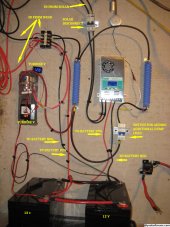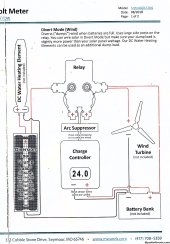Hogheavenfarm
Regulation Stifles Innovation
- Joined
- Jun 24, 2022
- Messages
- 432
I have been adding a solar component to my wind turbine for the purpose of keeping the batteries charged when we have some non-windy days. (Background - Two 100w solar panels feeding two parallel 12v batteries in parallel with a homebuilt F&P turbine) -
I am getting some unexpected overcharging issues under the following conditions: NO wind, solar only - batteries are reaching 15v and triggering the diversion load solenoid. This is happening every few minutes. The controller for the WIND is set to engage the dump load at 15v (for now, to test the solar controller behavior). The PowMr solar controller is set to 14.4v maximum, 13.8 float.
I expected the solar controller to limit the voltage to 14.4, but this doesn't seem to be happening , instead somehow the batteries go to 15v and trigger the dump load. This dumps for 5 seconds then shuts down. Batteries usually go to 13.6 or so after this, but within a few minutes are back to 15v.
I am attaching a pic in case I have a wiring issue someone can spot. (I know there are no fuses, etc on this yet, still a work in progress).
I am getting some unexpected overcharging issues under the following conditions: NO wind, solar only - batteries are reaching 15v and triggering the diversion load solenoid. This is happening every few minutes. The controller for the WIND is set to engage the dump load at 15v (for now, to test the solar controller behavior). The PowMr solar controller is set to 14.4v maximum, 13.8 float.
I expected the solar controller to limit the voltage to 14.4, but this doesn't seem to be happening , instead somehow the batteries go to 15v and trigger the dump load. This dumps for 5 seconds then shuts down. Batteries usually go to 13.6 or so after this, but within a few minutes are back to 15v.
I am attaching a pic in case I have a wiring issue someone can spot. (I know there are no fuses, etc on this yet, still a work in progress).




